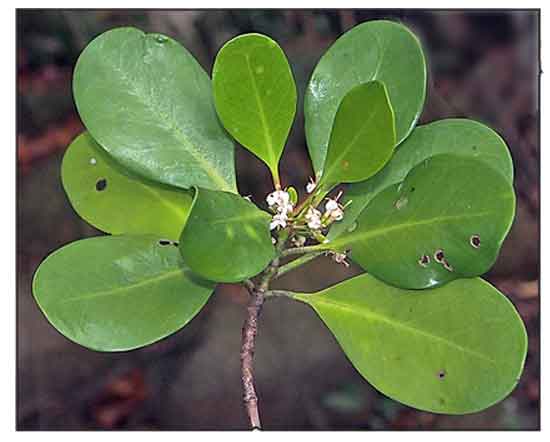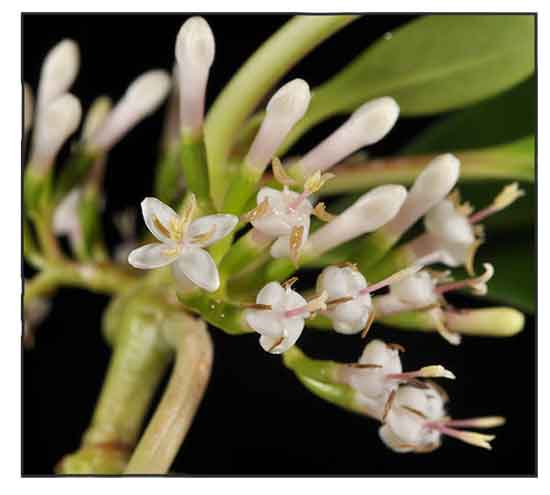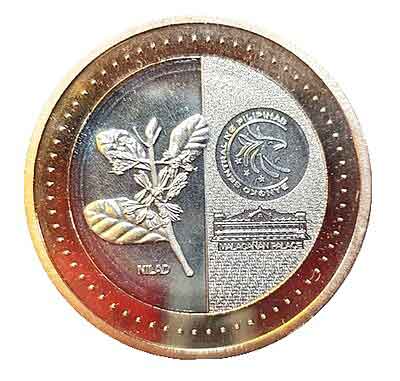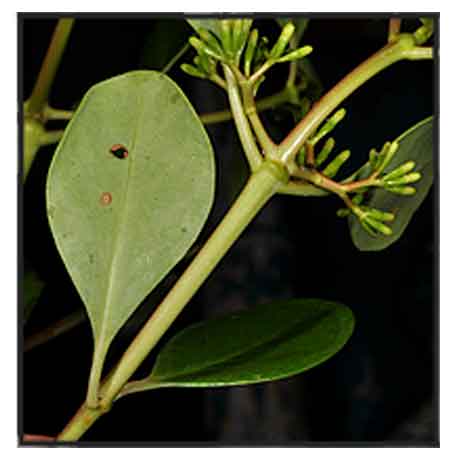 Gen info Gen info
- Scyphiphora is a monotypic genus of flowering plants in the family Rubiaceae. It is the only genus in the tribe Scyphiphoraceae. The genus contains only one species viz. Scyphiphora hydrophylacea.
- Etymology: The genus name Scyphiphora derives from Greek meaning "a two-handled cup", possibly referring to the stigma shape or the oblong fruit. The specific epithet hydrophylacea derives from Latin, referring to its resemblance to the genus Hydrophyllum. (4)
- Nila Nilad Maynilad Manila: The common name nila or nilad is believed to be origin of the capital city name, Manila, where the plant nilad was found. Folklore tells of two Spaniards inquiring on the source of Nilad bouquet arrangements, was told: "Sa intramuros, na may Nilad" (in Intramuros, where there are Nilads.)
Ergo, the tweaking journey from Nila to Nilad to Maynilad to Maynila to Manila. (5)
-
The short alternative story it that "Manila" is a Hispanized contraction of Maynilad, which means: "there is nilad". Alas, today, nilad trees, once abundant along the coast of Manila bay, are no longer found in the urbanized and concreted Manila, but may still be found in mangrove areas of the country.
- Coin snippet: The "Nilad" shares the reverse side (tail-face) of the 2019 20-peso Philippine coin (New Generation Currency Series), with Manuel L Quezon on the obverse. (image)
 Botany Botany
• Leaves are opposite. Leaf blades are broad and drop-shaped. Terminal buds and young leaves are coated with a varnish-like substance. Flowers are tubular and have four white lobes that are tinged pink, and arranged in dense clusters. Fruits are elliptic and deeply ridged, becoming light brown and buoyant when ripe. (3)
• Growth form: A shrub or small tree up to 6 m tall, occasionally with small stilt roots, and brownish-grey bark. Fruit is dispersed by water. Foliage: Opposite, stalked leaves have leathery blades that are usually drop-shaped to broadly elliptic with a rounded tip, light green, hairless on both sides, 4–7 by 2–4 cm, and have 4–6 pairs of veins that may be slightly visible or indistinct. Flowers: Flowers are pale pink to whitish-pink, 3–5 mm long, hairless outside, and arranged in 1.5–3 by 2–2.5 cm clusters. Fruit: Fruit is ellipsoid, green at first, turning yellow then shiny brown when mature, 8–10 by 4–5 mm, fleshy, hairless, have 6–10 longitudinal ridges, and consists of 2 parts with 2 seeds each. (4)
 Distribution Distribution
- Native to the Philippines.
- In mangrove swamps and along most tidal streams subject to the influence of salt or brackish water. Â (2)
- Also native to
Andaman Is., Bismarck Archipelago, Borneo, Cambodia, Caroline Is., Hainan, India, Jawa, Lesser Sunda Is., Madagascar, Malaya, Maluku, New Caledonia, New Guinea, Northern Territory, Queensland, Solomon Is., Sri Lanka, Sulawesi, Sumatera, Thailand, Vietnam. (1)
Constituents
- Study of chloroform and hexane extracts of dried pulverized leaves of mangrove plant S. hydrophyllacea isolated cytotoxic triterpenes identified as oleanolic acid (1), ursolic acid (2), and eichlerianic acid (3). (see study below) (9)
Properties
- Studies have suggested antiproliferative, antimicrobial, antioxidant, anti-hepatocarcinogeni properties.
Parts used
Leaves, shoots.
Uses
Edibility
- No reports found on plant edibility.
Folkloric
- Leaf extracts used for stomach aches. (3)
- In India, shoots used for treatment of liver problems. (10)
Others
- Wood: Dark brown wood used for making small craft objects. (3)
- Laundry: Flowers used as cleansing or whitening laundry agent. (3)
 Studies Studies
• Anti-Hepatocarcinogenic / Antioxidant / Leaves: Study evaluated the invitro anti-hepatocarcinogenic and antioxidant properties of various extracts of dried leaves of S. hydrophyllacea. Hexane and chloroform extracts were tested for pro-apoptotic properties in HepG2 cells. The hexane and chloroform extracts showed dose-dependent and time-dependent cytotoxic effects, with morphological changes related to apoptosis and significant (p<0.001) increase in caspase 3 and 9 levels in extract treated cells. Slight DNA fragmentation was observed, and mRNA expressions of p53 and Bax were significantly upregulated by low doses of n-hexane and chloroform extracts. Highest antioxidant activity was observed in the methanol extract. GC-MS identified lupeol, a known anticancer compound. Results showed cytotoxicity and antioxidant effects, and apoptosis-related changes by hexane and chloroform extracts, suggesting potential sources for isolation of possible anticarcinogenic compounds. (6)
• Cytotoxic / Antimicrobial / Endophytic Fungi: Study evaluated the antimicrobial and cytotoxic activities of endophytic fungi isolated from the mangrove plant Scyphiphora hydrophyllacea. Eleven fungal isolates were recovered and purified, and screened for cytotoxic activity and antimicrobial activity against human pathogenic microbes. Five isolates (45.5%) showed antimicrobial activity against growth of S. aureus, E. coli, and Candida albicans with ZOIs from 9.1 to 21 mm. Four extracts (36.4%) were cytotoxic (cell viability <50%) against T47D cells. Isolate ADSH2 which exhibited highest cytotoxic activity as identified as Penicillum chrysogenum. Results suggest the ethyl acetate extract of endophytic fungi associated with S. hydrophyllacea has potential as antimicrobial and anticancer compounds. (7)
• Hopenone / Antiproliferative Effects in Three Cancer Cell Lines: Study isolated active and antiproliferative compounds from hexane extract of leaves of mangrove plant S. hydrophyllacea. Antiproliferative properties of the isolated triterpenoid compound, hopenone-I, was evaluated against three cancer cell lines viz., MCF-7 (estrogen receptor positive breast cancer), HepG2 (hepatocellular carcinoma) and AN3CA (endometrial cancer) using MTT assay. Results showed promising antiproliferative effects in all cancer cell lines in a time and dose dependent manner. (8)
• Cytotoxic Triterpenes / MCF-7 and NHI-H-292 Cells / Leaves: Study of chloroform and hexane extracts of dried pulverized leaves of mangrove plant S. hydrophyllacea isolated active cytotoxic compounds. Isolated compounds were identified as oleanolic acid (1), ursolic acid (2), and eichlerianic acid (3). Compounds 2 and 3, isolated for the first time from the leaves, exhibited in-vitro cytotoxic effects in estrogen receptor positive (MCF-7) and non-small lung cancer (NHI-H-292) cells. (9)
• Anti-Liver Cancer / Dried Branches and Leaves/ Invention: Invention relates to a new function of S. hydrophyllacea and extractive in the preparation of anti-hepatoma agents. Experiment showed the ethyl acetate part derived from the extraction has stronger treatment function for hepatic tumor.
Availability
Wild-crafted.
Seeds in the cybermarket. |

![]()





 Distribution
Distribution
